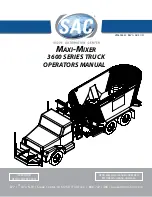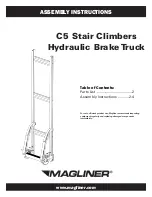
4' x 8'FOLDING ALUMINUM TRAILER KIT
Owner’s Manual
LIGHTING
• Check lighting before each use and every 100 miles to be sure the stop, tail, and turn signals
are working properly. REPLACE ANY BROKEN LENSES, EFLECTORS, OR BULBS.
• Check the wires for good connections and possible fraying or wearing of insulation.
• Lights supplied with this trailer are for 12-volt DC systems only. Do not attempt to power the
bulbs with any other type of voltage.
TIRES
• Check tires for wear, damage and proper inflation before each use and every 100 miles.
• Tire pressure should be kept at 60 PSI.
• Check and tighten the lug nuts. Torque to 85-90 ft.-lbs.
•
Re-torque the lug nuts after the first 25, 50 and 100 miles and before each tow thereafter.
OPERATION
• Tighten the trigger lock on the coupler and hook the safety chains securely (see Safety
Chains above and Coupler Operation below).After assembly and attachment, pull up and
down on the hitch coupler to make sure the hitch ball is snug in the hitch coupler. If the
coupler is not secured properly, it could come loose while the trailer is in motion, causing
property damage, serious personal injury or even death.
• Know how to properly control your tow vehicle-trailer combination on the highway under all
conditions. Remember the loaded weight of the trailer will increase your braking and
stopping distances appreciably.
• DO NOT allow anyone to ride on the trailer.
• Make wide turns when towing a loaded trailer, avoiding both sharp turns and U-turns. Turning
too sharply can cause damage to the trailer and/or the tow vehicle.
•
CAUTION:
Care must be taken when backing up the trailer; only back up the trailer on a
straight path. The trailer could jackknife if allowed to turn off the straight path while backing
up and possibly cause severe damage to the trailer and the tow vehicle.
• When towing a trailer over long distances, stop and check the tightness of all connections,
lights, and running gear every 100 miles.
• Carry emergency flares, and a fire extinguisher if required for operation in your state.
• It is recommended to carry extra bulbs and fuses if you are towing the trailer at night or over
any great distance.
• Whenever possible, park the trailer on a flat, level, paved surface and chock both tries to
keep the trailer from unexpectedly moving.
• Before attempting to fold up the trailer, make sure it is on a flat, level, solid surface and chock
both tires. Never attempt to fold up the trailer without the help of one or two able assistants.
COUPLER OPERATION
1. Temporarily remove the “R” pin and safety pin. Then, pull up on the trigger and lift up on the
handle.
NOTE:
To reduce friction between the hitch ball and coupler, apply a layer of heavy
weight grease over the hitch ball.
2. With assistance, place the trailer coupler over the vehicle’s hitch ball and pull back on the
trigger and push down on the handle until the trigger locks in the slot.
3. Pull up and down on the coupler to make sure the hitch ball fits snuggly in the coupler. There
should be no play between the hitch ball and coupler.
IMPORTANT:
If there is play, tighten the adjustment nut (shown below, right) until no play is
present – after unlocking the handle, the nut retaining plate (holding the adjusting nut in
place) needs to be pressed back while the nut is tightened. After the nut is tightened, the
retaining plate needs to be fit in place against the flats of the nut to prevent it from moving.
This adjustment should be done by two people. If the adjustment nut is too tight, the handle
will not lock.
After an adjustment of the nut, repeat steps 2 and 3 to properly attach the hitch and coupler.
4. Replace the safety pin and the “R” pin.
4' x 8'FOLDING ALUMINUM TRAILER KIT
Owner’s Manual
13 of 16
After Each Use
Check for damaged or cracked parts on the trailer after each use, including the tire condition
and pressure. This way replacement parts can be purchased and replaced before the next use.
Wash off the trailer to prevent dirt and road grime from hardening on the components.
Maintenance
Maintain your trailer. It is recommended that the general condition of any tool be examined
before it is used. Keep your tool in good repair by adopting a program of conscientious repair
and maintenance including the following points:
• Use only identical replacement parts on the trailer. Parts that may be suitable for a different
trailer may create a risk of injury when used with this trailer.
• Check and maintain the trailer, coupler, ball and hitch before each use and every 200 miles.
• To prevent bearing damage, disassemble and repack the wheel bearings with a good grade
of wheel bearing grease every 2000-3000 miles or yearly. If you do not know how to repack
wheel bearing, take your trailer to a qualified service technician.
• When servicing the trailer, check that the tire pressure is 60 PSI when the tires are cold. Refill
the tire with air as needed.
Store the trailer when it is not in use. Inspect the trailer for good working condition prior to
storage and again before re-use.
12 of 16



























